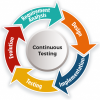Related Content
 |
Continuous Testing Is Not Automation Many people confuse continuous testing with test automation. That makes sense, because you cannot do continuous testing without automated tests. But it is much more. Continuous testing has a higher-level maturity that could require a totally different way of working—but it also gives a faster path to production. |
|
 |
FDA Updates Cybersecurity Recommendations for Medical Devices Because of the rapidly evolving nature of cybersecurity threats and risks, the U.S. Food and Drug Administration recently released a draft of updated premarket cybersecurity recommendations on how device manufacturers can better protect their products and proactively address security. |
|
 |
Solo Programming, Pairing, and Mobbing: Which Is Right for You? Programming often is considered an individual pursuit, but there are other options gaining popularity: pairing, where you work with another developer or tester, and mobbing, where the entire team works on one thing at a time. Each is effective for certain kinds of challenges. How much collaboration is right for you? |
|
 |
How Are You Managing Your Test Debt? Just as debt can be good and bad in everyday life (such as a home mortgage), debt in the engineering world can also be good and bad. This applies to quality engineering as well—with good and bad test debt. As testers, how do we create a balance and stay at the right test-debt quotient? |
|
 |
The New Reality of Mixed Reality Want to play with a porg? Walk on Mars? Or help those with autism practice social skills? Welcome to the new reality of mixed reality, where digital and physical objects coexist and interact to provide a new medium that a variety of organizations see as full of potential. |
|
 |
4 Lessons from the STARWEST 2018 Keynote Presentations With a week full of sessions, tutorials, training classes, and events, the STARWEST software testing conference had plenty of takeaways useful for your professional and personal life. Here are four lessons distilled from the conference’s keynote presentations on testing, communication, and directing your career. |
|
 |
Code Katas for Testers A kata is a small programming task you build a solution to. The point is to develop programming skill through familiarity with programming patterns, which is a useful practice for testers today. You’ll learn about software development, testing, continuous integration, exploration—and even how to be a better person. |
|
 |
Writing Tests: Action Abstraction Keywords have become a popular way of writing tests. Hans Buwalda used keywords to devise the Action Based Testing method in which tests are written as sequences of “actions” represented with keywords. However, keywords are just a physical representation of actions, and there are other ways to do this. |







